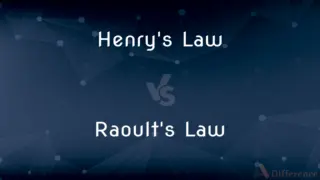Discrete Data vs. Continuous Data — What's the Difference?
Edited by Tayyaba Rehman — By Fiza Rafique — Published on December 18, 2023
Discrete Data consists of distinct, separate values, while Continuous Data can take any value within a range.

Difference Between Discrete Data and Continuous Data
Table of Contents
ADVERTISEMENT
Key Differences
Discrete Data represents information that can only take on certain distinct values. These values are often countable and cannot be subdivided further. For instance, the number of cars in a parking lot is a form of Discrete Data, as cars cannot be counted in fractions. On the other hand, Continuous Data represents measurements that can have infinite possibilities within a specific range. The weight of an individual, which can vary to a minuscule degree, represents Continuous Data.
When analyzing Discrete Data, one might observe distinct categories or groups. These can be easily graphed as bars, where each bar represents a distinct value or category. Conversely, Continuous Data might require different visualization techniques, like histograms or line graphs, to represent the endless possibilities within its range.
From a practical standpoint, Discrete Data can be seen in scenarios where exact numbers or categories are in focus. For example, the number of students in a classroom or the types of fruits in a basket. Continuous Data, however, is found in situations where measurements are taken. This includes the height of individuals in a population or the time taken for a task.
To illustrate further, consider a digital watch. If the watch only displays whole minutes, then it provides Discrete Data. However, if the watch showcases seconds or milliseconds, giving a continuous flow of time, it's showcasing Continuous Data.
It's vital to recognize the difference between Discrete Data and Continuous Data, as this distinction often guides the statistical methods and tools employed in data analysis. For instance, while averages might be used for both, medians might be more fitting for Continuous Data in certain scenarios.
ADVERTISEMENT
Comparison Chart
Nature
Distinct, separate values.
Can take any value within a range.
Graphical Representation
Bars for distinct values or categories.
Histograms or line graphs for infinite possibilities.
Examples
Number of cars, types of fruits.
Height of individuals, time taken for a task.
Subdivision
Cannot be subdivided further.
Can be divided infinitely.
Statistical Methods
Can use averages, but some methods may differ.
Averages and medians might be more fitting.
Compare with Definitions
Discrete Data
Discrete Data has distinct, countable values.
The number of pets in each household provides Discrete Data.
Continuous Data
Continuous Data can be infinitely subdivided.
The time taken for a race can be divided down to milliseconds, showcasing Continuous Data.
Discrete Data
Discrete Data often represents whole items or events.
The number of touchdowns in a football game is Discrete Data.
Continuous Data
Continuous Data can take infinite values within a range.
The height of students in a class offers Continuous Data.
Discrete Data
Discrete Data usually represents categories or groups.
The different shoe sizes sold in a store represent Discrete Data.
Continuous Data
Continuous Data represents measurements.
The temperature throughout a day is Continuous Data.
Discrete Data
Discrete Data cannot be further subdivided.
The number of books on a shelf is Discrete Data as you can't have half a book.
Continuous Data
Continuous Data does not have distinct categories.
The weight of fruits in a basket provides Continuous Data.
Discrete Data
Discrete Data is countable.
The number of students in a school is Discrete Data.
Continuous Data
Continuous Data shows a flow of values.
The changing water level in a dam over time is Continuous Data.
Common Curiosities
What is Discrete Data?
It consists of distinct, separate, and countable values.
What's an example of Continuous Data?
The height of individuals in a population.
How is Discrete Data typically represented graphically?
Using bars for distinct values or categories.
In which scenarios is Continuous Data typically found?
In situations where measurements are taken, like temperature readings.
Is time typically Discrete or Continuous Data?
Time is Continuous Data as it can be infinitely subdivided.
Is shoe size Discrete or Continuous Data?
It's Discrete Data, as sizes are distinct categories.
How does Continuous Data differ from Discrete Data?
Continuous Data can take any value within a range and can be infinitely subdivided.
Can Discrete Data be divided further?
No, it represents whole items or events and can't be subdivided.
How can Continuous Data be visualized?
Through histograms or line graphs.
Is the number of pages in a book Discrete or Continuous Data?
It's Discrete Data, as pages are countable and cannot be fractional.
Can Discrete Data take fractional values?
No, it represents distinct, whole values.
How does Continuous Data flow?
It offers a flow of infinite possibilities within a specified range.
What's a practical example of Discrete Data?
The number of apples in a basket.
Why is it vital to differentiate between Discrete and Continuous Data?
The distinction often guides the statistical methods and tools used in data analysis.
Can Continuous Data represent distinct categories?
No, it represents a flow of values without distinct breaks.
Share Your Discovery

Previous Comparison
Henry’s Law vs. Raoult’s Law
Next Comparison
Signed Char vs. Unsigned CharAuthor Spotlight
Written by
Fiza RafiqueFiza Rafique is a skilled content writer at AskDifference.com, where she meticulously refines and enhances written pieces. Drawing from her vast editorial expertise, Fiza ensures clarity, accuracy, and precision in every article. Passionate about language, she continually seeks to elevate the quality of content for readers worldwide.
Edited by
Tayyaba RehmanTayyaba Rehman is a distinguished writer, currently serving as a primary contributor to askdifference.com. As a researcher in semantics and etymology, Tayyaba's passion for the complexity of languages and their distinctions has found a perfect home on the platform. Tayyaba delves into the intricacies of language, distinguishing between commonly confused words and phrases, thereby providing clarity for readers worldwide.













































